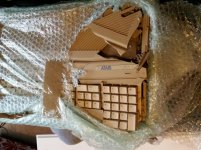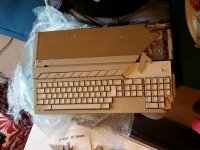reenigne
Veteran Member
I bought an Atari 520STFM from ebay, but unfortunately it was badly packed (bubble wrap and brown paper only, not even a cardboard box!) and when it arrived the case was smashed into a million pieces:


Fortunately the seller quickly gave me a full refund. The machine itself seems to work (I'm not sure about the floppy drive - I don't have any floppies for it yet). Unless I happen across a replacement case it'll never look the same again, but there seem to be enough large-ish pieces that I'm willing to have a go at trying to glue it back together (if nothing else just to make it possible to transport the machine without the keyboard falling off and flopping around).
Does anybody know what kind of plastic these cases are made out of and/or what is a good glue to use on them? I was going to use superglue (cyanoacrylate) but then I heard that it requires water to cure properly and therefore doesn't do a good job bonding smooth plastic surfaces. Also it makes a mess of acrylic, creating white cloudy patches near where the glue is applied.


Fortunately the seller quickly gave me a full refund. The machine itself seems to work (I'm not sure about the floppy drive - I don't have any floppies for it yet). Unless I happen across a replacement case it'll never look the same again, but there seem to be enough large-ish pieces that I'm willing to have a go at trying to glue it back together (if nothing else just to make it possible to transport the machine without the keyboard falling off and flopping around).
Does anybody know what kind of plastic these cases are made out of and/or what is a good glue to use on them? I was going to use superglue (cyanoacrylate) but then I heard that it requires water to cure properly and therefore doesn't do a good job bonding smooth plastic surfaces. Also it makes a mess of acrylic, creating white cloudy patches near where the glue is applied.
